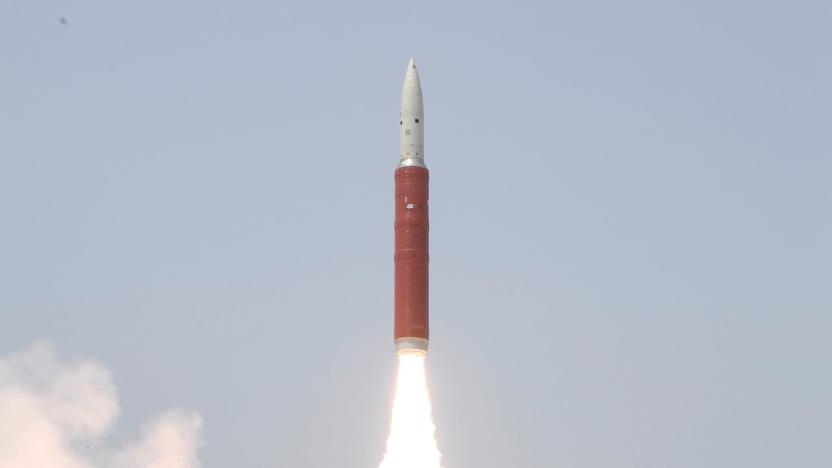missile
Latest

Russia says its hypersonic missile is now in active service
Russia's vaunted hypersonic missile is now in service -- though to what degree isn't clear. The country's Ministry of Defense has announced that the Avangard system is in use with its first regiment as of the morning of December 27th. The addition theoretically gives Russia the ability to strike targets around the world with relative impunity. The weapon launches like a conventional ballistic missile, but the re-entry vehicle glides into the atmosphere at extreme speeds while staying highly maneuverable at high altitudes -- it could be virtually impossible to stop using existing anti-missile systems.

Professor convicted of sending US missile chip technology to China
The American government is particularly wary of China these days, and it's determined to make an example out of those who would share US secrets with its major rival. A California federal court has convicted UCLA professor Yi-Chi Shih for reportedly stealing and sending missile guidance chip technology to China, not to mention separate charges for fraud, false tax returns and false statements to agency staff.

US cyberattack reportedly knocked out Iran missile control systems
The US may have withheld a physical military response to Iran shooting down a drone, but it might not have shown similar restraint with a digital campaign. Washington Post sources say the President greenlit a long-in-the-making cyberattack that took down Iranian missile control computers on the night of June 20th. The exact impact of the Cyber Command operation isn't clear, but it was described as "crippling" -- Iran couldn't easily recover, one tipster said.

CIA 'Ninja bomb' replaces explosives with six long blades
The US apparently has a unique approach to minimizing bystander casualties from drone strikes: replace the warhead with old-fashioned knives. The Wall Street Journal has learned that both the CIA and the Pentagon have been using a variant of the Hellfire air-to-ground missile, the R9X (aka "Ninja bomb"), that deploys six blades moments before impact to cut through virtually anything in its path, including buildings and cars. The idea is to take out a terrorist leader or a similarly prominent target without risking the lives of nearby civilians.

US Air Force successfully shoots down multiple missiles with a laser
The US Air Force just edged closer to its goal of outfitting aircraft with laser weapons. Testers at the White Sands Missile Range have successfully shot down multiple air-launched missiles using the Self-Protect High Energy Laser Demonstrator (SHiELD), proving that it can hold up under intense situations. While SHiELD is currently a ground-based behemoth (see below), the finished technology should be portable and rugged enough to be used aboard aircraft.

NASA says satellite that India shot down may threaten the ISS
NASA chief Jim Bridenstine called India's destruction of one of its satellites a "terrible, terrible thing" that could endanger astronauts aboard the International Space Station (ISS). Addressing employees, he said a missile that shot down a satellite created at least 400 pieces of orbital debris, including 60 larger than 6 inches in size. While the satellite was well below the ISS, 24 of the pieces were blasted above its apogee, creating a potential risk. "It's unacceptable and NASA needs to be very clear about what its impact to us is," Bridenstine said.

The rise and fall of rocket mail
As you read this, countless cards, letters and packages are en route to delivery destinations across the globe. We rarely think about the logistics involved in international mail crossing land and sea, country borders and continents, because we don't have to. We simply take our item to the nearest postal service branch, pay an acceptable conveyance fee, and within a week or sooner, that item can end up on the other side of the world. But some two hundred years ago, eccentric minds were devising ways of cutting international delivery times to hours or even minutes. Their method? Rockets.

Russia tested a hypersonic missile it claims will beat all defenses
Russia might have advanced the development of a hypersonic missile system. State-backed media reports that the Defense Ministry has successfully tested Avangard, which mates an ICBM with a glide vehicle that travels up to Mach 5. Officials say they launched the missile from the Orenburg area (near western Kazakhstan) and hit a target thousands of miles away at a test range in Kamchatka. Not surprisingly, the test was conducted on orders from President Putin.

The US ballistic missile system is a cybersecurity nightmare
The US Department of Defense Inspector General has recently taken a close look at the country's Ballistic Missile Defense System (BMDS) and found its cybersecurity measures lacking in many, many aspects. In the report (PDF) published in April and unearthed by ZDNet, the Inspector General detailed the flaws it found in five random locations where the Missile Defense Agency installed ballistic missiles as part of the program. One of the most common issues it came across was lax enforcement when it comes to multi-factor authentication.

Hawaii officials fire officer who triggered false missile alarm
On January 13th, an officer of the Hawaii Emergency Management Agency (HI-EMA) triggered a missile alert that plunged residents statewide into temporary chaos before the alarm was called off as a mistake. While news emerged yesterday that the employee actually believed the attack was real after misinterpreting a message, and therefore didn't trip the alarm in error, that wasn't a good enough reason to panic the nation. The officer has been fired and the emergency management leader responsible for the agency, Vern Miyagi, has resigned.

False alarm: Emergency alert in Hawaii claims 'missile inbound'
A few minutes ago, phones across Hawaii received the above emergency alert about a "ballistic missile threat inbound," but according to state officials, it isn't true. US Rep. Tulsi Gabbard, Hawaii's governor David Ige and the state's Hawaii Emergency Management Agency all chimed in on Twitter to confirm the alert is false. It took 38 minutes before a second alert reached phones, confirming that the first one was a mistake. Honolulu police confirmed in a post that "State Warning Point has issued a Missile Alert in ERROR!," while Buzzfeed reporter Amber Jamieson tweets that one EMA employee said it was a part of a drill. US Senator from Hawaii Brian Schatz said the "inexcusable" alert "was a false alarm based on a human error" while the National Weather Service called it a "test message."

China reportedly tests new ballistic weapon that flies under radar
A US government source told The Diplomat this week that China has conducted flight tests of a missile equipped with a hypersonic glide vehicle (HGV). Two tests of the HGV, a model known as the DF-17, took place in November and China is understood to have conducted a number of other tests of experimental HGVs throughout 2014 and 2016. The DF-17 is thought to have a range of between 1,800 and 2,500 kilometers and represents a new kind of weapon system, one that the US and Russia are also developing.

US and Australia finish a key round of hypersonic missile tests
The US and its allies are determined to be first out of the gate with hypersonic weapons, and they've just taken a big stride forward in that regard... not that they're saying much about it. Both the US and Australia have confirmed that they recently completed a series of mysterious hypersonic missile tests. All the countries will say is that the flights were successful, and that they represented "significant milestones" in testing everything from the design assembly to the control mechanisms. They won't even say which vehicles were used or how quickly they traveled, although past tests have usually relied on Terrier Orion rockets (above) and have reached speeds as high as Mach 8.

American special forces open a drone hacker lab
Battlefield drones are evolving quickly, and there's only so much militaries can do to keep up -- they're not used to competing with consumer tech that can improve in a matter of months. To that end, US Special Operations Command (aka SOCOM) is taking the unusual step of opening a drone hacker lab in Tampa, Florida at an unspecified point in the future. The organization's James Geurts hopes this tinkerer mindset will help special forces "get out in front" of threats that could easily prove overwhelming, such as drone swarms. There are also more direct problems to solve, such as balancing weapon payloads and portability. You may need a drone bigger than something like the tiny, kamikaze-oriented AeroVironment Switchblade (above) to take down a target, but you can't always field more conventional runway-bound drones to do the job.

US hopes cyberattacks will stall North Korea's missile program
The US might not have had much success with cyberattacks against North Korea's nuclear program, but that apparently hasn't stopped officials from further efforts... not that they're having much success. The New York Times has learned that then-President Obama ordered escalated cyberwarfare against North Korea in 2014 a bid to thwart its plans for intercontinental ballistic missiles. However, it's not clear that this strategy has worked -- and there may be problems if it does.

The US is preparing to modernize its nuclear weapons systems
The United States has not updated its nuclear weapons program in decades, but in February President Barack Obama allocated more than $1 trillion to the modernization of the country's nuclear stockpile. Perhaps he got tired of hearing jokes about servicemen using floppy disks to activate missiles, but regardless of the catalyst, the US is preparing to create a brand new nuclear weapons system that includes connecting its missiles via a secure network. In 2017, 50 men and women on the Air Force Scientific Advisory Board will be tasked with figuring out what could go wrong in this brave new world, Defense One reports.

US Navy fighter jets will carry an autonomous anti-ship missile
The US Navy may have a robotic ace in the hole when it fights enemy warships in the future. It's planning to put Lockheed Martin's autonomous LRASM (Long Range Anti-Ship Missile) on the F/A-18 Super Hornet by 2019, giving jet fighters a weapon that tracks and wipes out targets mostly or entirely on its own. Most of the missile's details are secret, but it's smart enough to dodge obstacles on the way to vessels as far as 200 nautical miles out -- and that's the unclassified range, which suggests that it's more capable in practice. There are also versions of LRASM in the works that will launch from ships, submarines and other aircraft, so this intelligent projectile could soon be a mainstay of the US military.

The Big Picture: This missile can knock out warheads in space
Rising from a wall of flames, a Raytheon RIM-161 Standard Missile-3 (SM-3) takes flight from the Deveselu missile defense base in Romania. Designed to intercept short- and intermediate-range ballistic missiles before the inbound threats re-enter the atmosphere, the SM-3 has been likened to "shooting a bullet with another bullet." The armament is deployed both on land and at sea where it is utilized as part of the Navy's Aegis Ballistic Missile Defense.

Watch a remote-controlled fighter jet evade a missile
Existing drone aircraft are useful for many things, but they make for lousy target practice when you're testing missiles; they're rarely as maneuverable as modern fighter jets. Boeing and one of its customers have just shown that there's a better way, however, by firing a surface-to-air missile at a remote-controlled QF-16. As you'll see in the video below, the unmanned aircraft is much nimbler than either a purpose-built vehicle or an aging conversion like the QF-4, and gives weapons a real workout. It even managed to dodge the projectile, although you can't really say that the shooters missed. The missile was tuned to avoid hitting its target -- sensors on both the missile and QF-16 confirmed that the weapon was on track without having to blow up expensive equipment. It'll be a while longer before the airplane is regularly serving as an aerial punching bag, but this test proves that it's up to the job.

US Army researchers weigh the benefits of 3D-printed warhead parts
It's no secret that 3D printing is making big strides for the future of not just technology, but medicine and space exploration as well. And the United States Army is looking to leverage the platform for its warhead production. 3D printing is nothing new to this particular branch of the military, as it has been working on bioprinted replacement skin for battle wounds -- amongst other projects. The Army is looking to implement the tech to produce components for the weapons that will both reduce cost and increase customization. "The real value you get is you can get more safety, lethality or operational capability from the same space," said materials engineer James Zunino. Part of the allure here is that warheads could also be built to suit each mission, rather being mass-produced to outfit a range of duties. But the Army isn't stopping with pieces: the possibility of printing an entire rocket isn't too far fetched given how quickly 3D printing continues to develop. As with any military-grade weapon, the risk of the production files falling into the wrong hands is certainly a concern. [Photo credit: Aamir QureshiI/AFP/Getty Images]









